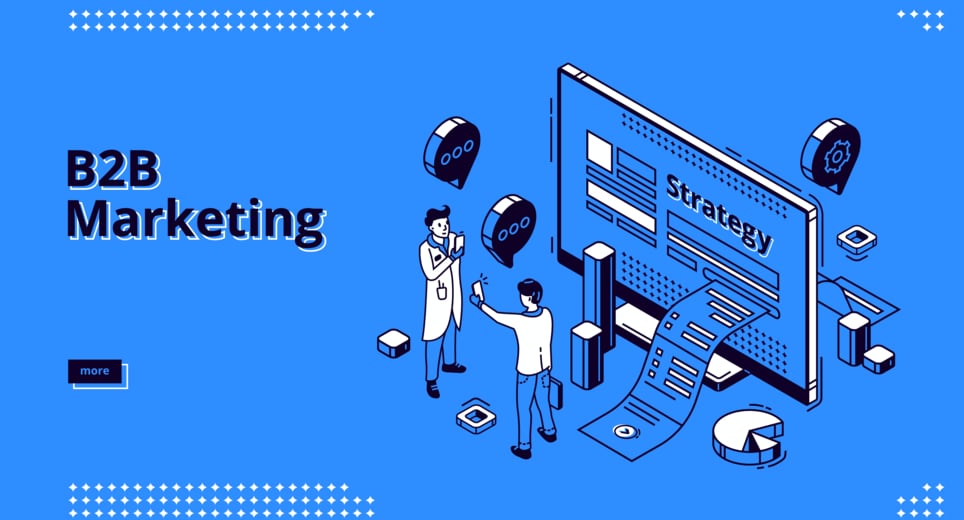If you’re wondering how to scale a business quickly with limited resources and lots of creativity, growth hacking can provide the solution. With B2B businesses, the relationship with leads often requires more time, attention, and nurturing before getting a conversion. However, a B2B business can scale quickly despite a more complex audience.
Here are several strategies to help you generate a high volume of qualified b2b leads and improve your online sales performance:
Here are several strategies to help you generate a high volume of qualified b2b leads and improve your online sales performance:
Understand the Buyer's Journey
Rarely ever does a customer go from viewing an ad to making a purchase right away, especially with high ticket items. There are often many touchpoints in between such as reading reviews, engaging with your emails, or reading your blog. A critical growth hacking strategy is learning as much as you can about your customers, which means understanding how they go from lead to evangelist. Firmographic segmentation is an essential B2B marketing strategy if you want to do just that.
Once you understand the buyer’s journey, you will be able to improve your marketing process at every stage and lessen the time it takes to convert. Growth hacking is about iterating until you find the perfect mix of marketing and understanding the buyer's journey helps you do that.
While there are different templates of what a buyer's journey might look like, a popular model consists of the journey broken down into three parts: the awareness, consideration, and decision stages.
An example of using the buyer's journey to improve the sales process is sending an email with testimonials to a lead in the decision stage. At this stage, the lead is considering different products that will solve their problem. If the lead is considering alternative products, seeing the positive experience of current customers can persuade them to purchase.
However, if you send the email of testimonials to your lead before they fully understand their problem, as in the awareness stage, the content will likely have less of an impact. Sending the right content at the right time is what understanding the buyer’s journey allows you to do.
Once you understand the buyer’s journey, you will be able to improve your marketing process at every stage and lessen the time it takes to convert. Growth hacking is about iterating until you find the perfect mix of marketing and understanding the buyer's journey helps you do that.
While there are different templates of what a buyer's journey might look like, a popular model consists of the journey broken down into three parts: the awareness, consideration, and decision stages.
An example of using the buyer's journey to improve the sales process is sending an email with testimonials to a lead in the decision stage. At this stage, the lead is considering different products that will solve their problem. If the lead is considering alternative products, seeing the positive experience of current customers can persuade them to purchase.
However, if you send the email of testimonials to your lead before they fully understand their problem, as in the awareness stage, the content will likely have less of an impact. Sending the right content at the right time is what understanding the buyer’s journey allows you to do.

Proper Data Collection
Any growth hacking strategy is only as good as your data collection process. The key to the success of growth hacking is seeing that something isn’t working and pivoting quickly. You’ll only be able to do that if your data collection is solid.
For example, if you have a landing page for your product and visitors are bouncing (when they enter the site and then leave without visiting other pages or taking action) that's an indication that you should try something different. Maybe your copy isn’t clear or your call to action isn’t obvious enough. Whatever the case, you’ll only be able to identify this issue by looking at the data.
When it comes to marketing automation and analytics, there’s no shortage of free and paid tools at your disposal. For your website, Google Analytics is a great source of information. For your emails, your email service provider can provide you with metrics on how your emails are performing. In addition, tools like HotJar, SEMrush, and the Adwords Performance Grader all provide data related to a specific marketing activity.
The benefit of analyzing data relevant to your business processes is you can try new things and measure the effect on sales. Deciding what Key Performance Indicators (KPIs) to use is important because you want to make sure you are looking at the metrics that matter most to your sales.
There’s an infinite number of data points that can be collected and measured for your business. When it comes to choosing the right KPIs you have to consider what metrics impact the bottom line. Likes on social media are great, but if they don’t turn into website visits, and ultimately sales then they’re useless.
For example, if you have a landing page for your product and visitors are bouncing (when they enter the site and then leave without visiting other pages or taking action) that's an indication that you should try something different. Maybe your copy isn’t clear or your call to action isn’t obvious enough. Whatever the case, you’ll only be able to identify this issue by looking at the data.
When it comes to marketing automation and analytics, there’s no shortage of free and paid tools at your disposal. For your website, Google Analytics is a great source of information. For your emails, your email service provider can provide you with metrics on how your emails are performing. In addition, tools like HotJar, SEMrush, and the Adwords Performance Grader all provide data related to a specific marketing activity.
The benefit of analyzing data relevant to your business processes is you can try new things and measure the effect on sales. Deciding what Key Performance Indicators (KPIs) to use is important because you want to make sure you are looking at the metrics that matter most to your sales.
There’s an infinite number of data points that can be collected and measured for your business. When it comes to choosing the right KPIs you have to consider what metrics impact the bottom line. Likes on social media are great, but if they don’t turn into website visits, and ultimately sales then they’re useless.

Free marketing analytics tools
While there are hundreds of tools that will let you collect and analyze marketing and sales data, here are the best free tools for data analytics:
• Google Analytics is an extremely robust tool that will measure website traffic. It provides detailed information about your visitors that you can use to inform your marketing, such as location, devices, age of visitors, and more. It also tracks important website metrics like how long users stay on a page and how many users visit only one page and leave (bounce rate).
• Google Search Console can provide important SEO insights like how many sites are linking to you (a critical factor in SEO), and what keywords your site appears for.
• SEMrush will allow you to easily track keywords and measure your rank for those keywords. Keyword ranking is a critical measure of SEO. This service allows you to compare your SEO efforts to your competitors. The free version of this tool allows you to track up to 19 keywords.
• Databox is a data analytics dashboard that allows you to track a variety of metrics in one place. The benefit of having one central location for all of your marketing and sales data can not be overstated.
• HubSpot is a customer relationship management software that allows you to add contacts (names and email addresses of leads) and send them templated emails. The platform is much more robust than that, but one of the best free benefits is the ability to see detailed analytics for the emails you send (open rate, click rates, top engaged contacts, etc).
• Smartlook is a free heat mapping software. Heat maps capture where your website visitors are clicking and spending the most time on your website. This insight helps you to determine which content is successful and which content should be changed to get the desired outcome – a conversion.
Creating Free Content
When a business has limited resources, an inexpensive way to attract leads is to provide valuable free content, also known as inbound marketing. When you provide content that your ideal customer finds helpful, entertaining, or enlightening you start to build trust. When you’ve established a trusting relationship between you and your ideal customer, it’s easier to ask for the sale.
The key to creating content is that the content must be valuable, especially when you’re asking for something in return such as an email address or phone number. Creating outstanding content is one of the top B2B demand generation strategies you can use to fill up your sales funnel. Sending your lead fluff or bad-quality content is the fastest way to erode trust and lose the sale.
When you create quality content and provide it to your lead you have an opportunity to nurture them through the buyer’s journey. You can educate them about your product, overcome any objections they may have, and incentivize them to make a purchase. You don't want to limit yourself to educational content though. Creating content with a transactional or commercial intent can help with sales enablement and sales operations.
When you get a quality lead, it’s important not to squander it by not being prepared. Whether your lead comes from your brand awareness campaigns, referrals, word of mouth, cold outreach or from a B2B lead generation service, you must engage and educate your lead with content that will demonstrate how your product can solve their problem. Another goal of your content is to position your company as competent and trustworthy.
Types of content you can create:
• Quizzes
• Ebooks
• Case Studies
• Blogs
• Videos
• Checklists
• Infographics
• Podcasts
The key to creating content is that the content must be valuable, especially when you’re asking for something in return such as an email address or phone number. Creating outstanding content is one of the top B2B demand generation strategies you can use to fill up your sales funnel. Sending your lead fluff or bad-quality content is the fastest way to erode trust and lose the sale.
When you create quality content and provide it to your lead you have an opportunity to nurture them through the buyer’s journey. You can educate them about your product, overcome any objections they may have, and incentivize them to make a purchase. You don't want to limit yourself to educational content though. Creating content with a transactional or commercial intent can help with sales enablement and sales operations.
When you get a quality lead, it’s important not to squander it by not being prepared. Whether your lead comes from your brand awareness campaigns, referrals, word of mouth, cold outreach or from a B2B lead generation service, you must engage and educate your lead with content that will demonstrate how your product can solve their problem. Another goal of your content is to position your company as competent and trustworthy.
Types of content you can create:
• Quizzes
• Ebooks
• Case Studies
• Blogs
• Videos
• Checklists
• Infographics
• Podcasts
After The Purchase
One of the most overlooked growth hacking tools is customer retention. It costs a lot of money to acquire a customer, and it costs a lot less to retain an existing customer. Customer retention comes down to providing an excellent customer experience.
If a customer has an awful purchase experience or even just an average one, it’s easy for your competition to woo them away. Contrarily, it’s hard for a customer to walk away from an exceptional purchase experience and a product that fulfills their need.
Picture this scenario: You sell a customer a very expensive software product after months of nurturing them. After you make the sale, no one contacts the customer again. The customer is struggling with how to use the product effectively, decides your product is too difficult, and at first chance runs to your competitor.
Forgetting a customer after they've made the purchase is the easiest way to lose the customer in the future. Retaining customers is an important growth hacking strategy. When you provide an exceptional customer experience, not only can you expect repeat customers, you can expect your customers to sing your praises, and nothing scales a business like word of mouth advertising.
If a customer has an awful purchase experience or even just an average one, it’s easy for your competition to woo them away. Contrarily, it’s hard for a customer to walk away from an exceptional purchase experience and a product that fulfills their need.
Picture this scenario: You sell a customer a very expensive software product after months of nurturing them. After you make the sale, no one contacts the customer again. The customer is struggling with how to use the product effectively, decides your product is too difficult, and at first chance runs to your competitor.
Forgetting a customer after they've made the purchase is the easiest way to lose the customer in the future. Retaining customers is an important growth hacking strategy. When you provide an exceptional customer experience, not only can you expect repeat customers, you can expect your customers to sing your praises, and nothing scales a business like word of mouth advertising.

Closing Thoughts About Using B2B Growth Hacking to Improve your Online Sales Performance
While there are a lot of B2B marketing strategy frameworks, techniques and strategies you can use to increase sales, understanding your audience and their journey toward a purchase is the most impactful thing you can do. Hiring a business performance specialist can definitely help you get much better results. Using that knowledge to create content and provide your customers with the best possible experience is always a winning strategy.At Growth Hackers, as a growth hacking agency, we help entrepreneurs and businesses succeed. Indeed, we help startups, entrepreneurs, business owners and established brands with low to high ticket digital marketing, lead generation, conversion rate optimization and growth hacking. Entrepreneurs contact us to help them launch their businesses. Businesses contact us to help them grow their businesses through automation, lead generation, sales funnels and more. Contact someone from the Growth Hackers' team today if you want to apply some growth hacking tactics and propel your business.




